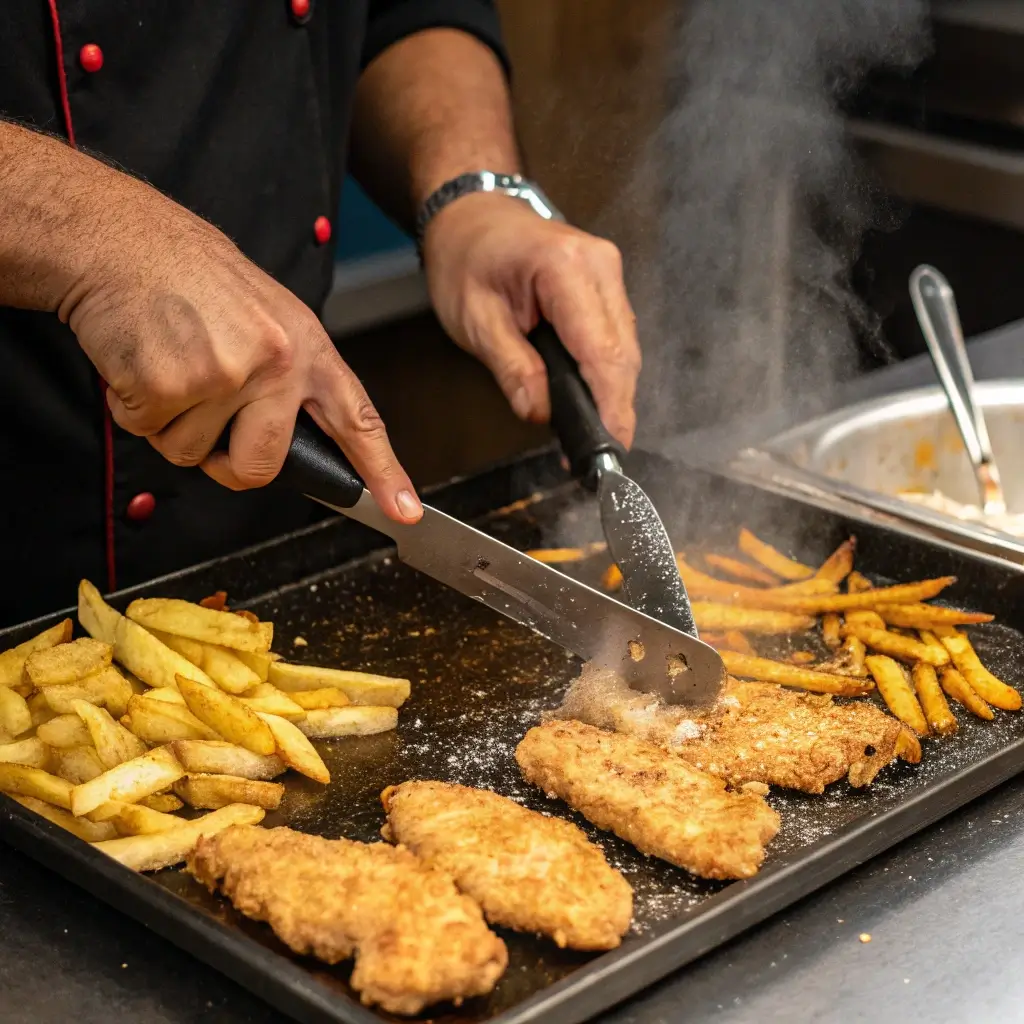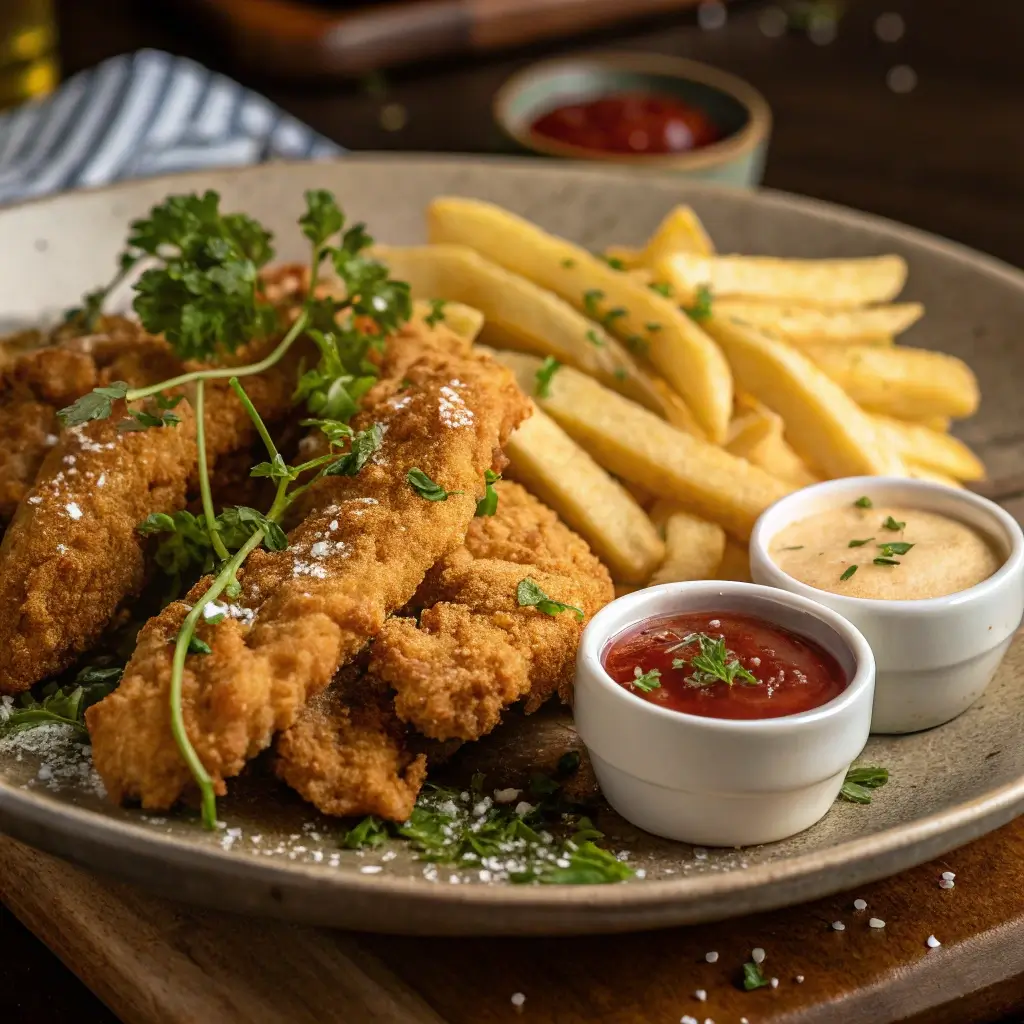Chicken Tenders and Fries Calories are a beloved comfort food combination that has found its way into the hearts (and stomachs) of people worldwide. Whether you’re enjoying them at a fast-food restaurant, a casual diner, or making them at home, this meal is a go-to for its crispy, savory, and satisfying flavors. However, as more people become conscious of their caloric intake, nutritional choices, and overall health, the question arises: Can you still enjoy chicken tenders and fries without derailing your health goals? In this comprehensive guide, we’ll dive deep into the calories and nutritional content of this classic dish, explore its impact on your health, and provide healthier alternatives that allow you to indulge without guilt.
Table of Contents
Why You’ll Love This
Understanding the nutritional breakdown of your favorite foods is essential for making informed dietary decisions. By learning about the calories, macronutrients, and micronutrients in chicken tenders and fries, you can better manage your intake and discover ways to make this meal healthier. Whether you’re aiming to reduce calories, cut down on fat, increase protein, or simply enjoy a more balanced version of this comfort food, this guide will equip you with the knowledge and tools to do so. Plus, with a variety of healthier alternatives and preparation methods, you’ll never have to feel like you’re missing out.
Ingredients
To fully grasp the calories and nutritional profile of chicken tenders and fries, let’s start by examining the typical ingredients used in this dish:
Chicken Tenders
- Chicken Breast: The primary protein source, usually cut into strips.
- Breading: A mixture of flour, eggs, and breadcrumbs for that crispy coating.
- Oil: Used for deep-frying, which adds significant calories and fat.
French Fries
- Potatoes: Cut into strips, often soaked in water to remove excess starch.
- Oil: Used for frying, contributing to the calorie and fat content.
- Salt: Added for flavor, but it can increase sodium levels.
Dipping Sauces
- Ketchup: A classic choice, but often high in sugar.
- Ranch: Creamy and flavorful, but calorie-dense.
- Honey Mustard: A sweet and tangy option.
- Barbecue Sauce: Rich and smoky, but often high in sugar and sodium.
Seasonings
- Salt and Pepper: Basic seasonings for enhancing flavor.
- Paprika, Garlic Powder, or Cayenne: Optional spices for added depth.
These ingredients come together to create a meal that’s delicious but often high in calories, fat, and sodium. Below, we’ll break down the nutritional content and explore ways to make this dish healthier.
Variations
While traditional chicken tenders and fries are undeniably tasty, there are countless ways to tweak this dish to make it healthier or more exciting. Here are some popular variations:
Baked Chicken Tenders
Skip the deep-frying and bake the tenders in the oven. This method significantly reduces the amount of oil used, cutting down on calories and fat while still delivering a crispy texture.
Air-Fried Fries
Use an air fryer to achieve the same crispy texture as traditional fries but with a fraction of the oil. This method is a game-changer for those looking to enjoy fries without the guilt.
Gluten-Free Tenders
For those with gluten sensitivities or celiac disease, use almond flour, coconut flour, or gluten-free breadcrumbs to coat the chicken. This variation is just as delicious and caters to dietary restrictions.
Sweet Potato Fries
Swap regular fries for sweet potato fries. Sweet potatoes are rich in vitamin A, fiber, and antioxidants, making them a more nutritious alternative.
Grilled Chicken Strips
Skip the breading altogether and grill the chicken strips. This method reduces calories and fat while keeping the protein content high. Pair with a side of roasted vegetables for a balanced meal.
Zucchini Fries
For a low-carb alternative, try zucchini fries. Simply coat zucchini strips in breadcrumbs and bake or air-fry until crispy. They’re light, flavorful, and packed with nutrients.
Each variation offers a unique twist on the classic dish, allowing you to customize it to your dietary needs and preferences.
Steps

If you’re making chicken tenders and fries at home, here’s a step-by-step guide to preparing this meal:
1. Prepare the Chicken Tenders
- Cut chicken breast into even strips.
- Set up a breading station with three bowls: one with flour, one with beaten eggs, and one with breadcrumbs.
- Dip each chicken strip into the flour, then the eggs, and finally the breadcrumbs, ensuring an even coating.
- Heat oil in a pan or deep fryer to 350°F (175°C).
- Fry the tenders in batches until golden brown and cooked through (about 4-5 minutes per side).
2. Prepare the Fries
- Cut potatoes into thin, even strips.
- Soak the strips in cold water for 30 minutes to remove excess starch.
- Pat the strips dry with a paper towel.
- Heat oil in a deep fryer or large pot to 375°F (190°C).
- Fry the potatoes in batches until golden and crispy (about 5-7 minutes).
3. Season and Serve
- Sprinkle salt and pepper over the fries and tenders.
- Serve with your favorite dipping sauces, such as ketchup, ranch, or honey mustard.
While this method yields delicious results, it’s also high in calories and fat. Below, we’ll explore healthier preparation methods.
Tips and Tricks
To make your chicken tenders and fries healthier without sacrificing flavor, try these tips:
1. Use Whole-Grain Breadcrumbs
Swap regular breadcrumbs for whole-grain or panko breadcrumbs. These options add fiber and nutrients, making the dish more wholesome.
2. Bake Instead of Fry
Baking reduces the amount of oil used, cutting down on calories and fat. To achieve a crispy texture, spray the tenders and fries with a light coating of cooking spray before baking.
3. Opt for Homemade Sauces
Store-bought dipping sauces are often high in sugar, sodium, and preservatives. Make your own sauces using Greek yogurt, mustard, or avocado for a healthier alternative.
4. Season Generously
Use herbs and spices like paprika, garlic powder, or cayenne to add flavor without extra calories. Experiment with different seasoning blends to keep things interesting.
5. Control Portion Sizes
Stick to smaller portions to keep calorie intake in check. Pair your tenders and fries with a side salad or steamed vegetables to create a more balanced meal.
6. Try Air-Frying
An air fryer is a fantastic tool for making crispy chicken tenders and fries with minimal oil. It’s a healthier alternative to deep-frying and delivers similar results.
How to Serve
Chicken tenders and fries are versatile and can be served in many ways. Here are some ideas:
1. Classic Combo
Serve the tenders and fries with ketchup, ranch, or honey mustard for a traditional experience.
2. Salad Topping
Slice the tenders and add them to a fresh green salad for a protein boost. Drizzle with a light vinaigrette for a complete meal.
3. Wrap or Sandwich
Place the tenders in a whole-grain wrap or bun with lettuce, tomato, and a light sauce for a quick and satisfying meal.
4. Kid-Friendly Platter
Serve with a side of fruit or veggies to make the meal more balanced and appealing to kids.
5. Gourmet Platter
Elevate your presentation by arranging the tenders and fries on a wooden board with small bowls of dipping sauces and a sprinkle of fresh herbs.
Make Ahead and Storage
Chicken tenders and fries can be prepared ahead of time and stored for later use. Here’s how:
1. Make Ahead
Cook the tenders and fries, let them cool, and store them in an airtight container in the refrigerator for up to 3 days.
2. Freezing
Place the cooked tenders and fries on a baking sheet, freeze until solid, then transfer to a freezer-safe bag. They can be stored for up to 2 months.
3. Reheating
Reheat in the oven or air fryer to maintain crispiness. Avoid microwaving, as it can make the fries soggy.
FAQs
1. How many calories are in chicken tenders and fries?
A typical serving of chicken tenders and fries contains around 800-1,200 calories, depending on the portion size and cooking method.
2. Are chicken tenders and fries unhealthy?
While delicious, they are often high in calories, fat, and sodium. However, healthier preparation methods can make them a better option.
3. What are healthier alternatives to fries?
Try sweet potato fries, zucchini fries, or baked carrot fries for a nutrient-rich alternative.
4. Can I make gluten-free chicken tenders?
Yes! Use gluten-free flour and breadcrumbs to make gluten-free chicken tenders.
5. How can I reduce the fat content?
Bake or air-fry the tenders and fries instead of deep-frying to significantly reduce fat.
6. Are there low-carb options?
Yes! Replace fries with zucchini fries or jicama fries for a low-carb alternative.
Conclusion

Chicken tenders and fries may be a classic comfort food, but they don’t have to be a guilty pleasure. By understanding their caloric content and nutritional value, you can make smarter choices and enjoy this dish in a healthier way. Whether you opt for baked tenders, air-fried fries, or creative alternatives, there are plenty of ways to indulge without compromising your health. So, the next time you’re craving this combo, try one of the healthier alternatives and savor every bite!
For more information on the nutritional content of chicken. Happy cooking!

